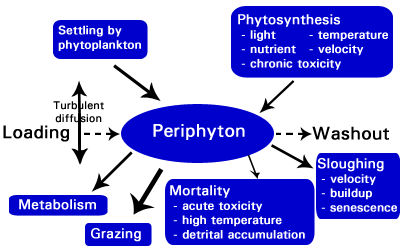Modeling Periphyton with AQUATOX
Periphyton are benthic algae and associated organic detritus that are attached to hard substrates and macrophytes and that carpet stabilized sands. Many streams and rivers are impaired because of nuisance levels of periphyton due to nutrient enrichment. Few water quality models simulate periphyton in streams with any accuracy because of the many factors affecting them. AQUATOX has the capability to simulate periphyton, in response to changing nutrient, light, grazing, and flow conditions.
- Background
- Why are Periphyton so difficult to predict?
- How Aquatox models Periphyton
- Example application of AQUATOX to Woodland stream
Background
Periphyton are the benthic algae and associated organic detritus that are attached to hard substrates and macrophytes and that carpet stabilized sands. They are an important constituent of the aquatic community, especially in shallow lakes, ponds, streams, and rivers. Many of the nation's rivers and streams are impaired because of nuisance levels of periphyton due to nutrient enrichment. Although periphyton are nominally included in several water quality models, they have been difficult to model with any degree of accuracy.
AQUATOX has the capability to simulate periphyton over time, not only in response to nutrient enrichment, but also by accounting for the accumulation of live and dead material in the algal mat, and by simulating sloughing, the almost instantaneous loss of an entire algal mat under high flow and deteriorating environmental conditions. The periphyton submodel was calibrated with data from a series of stream experiments, and was verified using an independent dataset. When compared with data collected under ambient conditions, there was good agreement between observed values and model predictions, accurately representing the effects of grazers, self shading, variable currents, and variable light conditions, including shading by riparian vegetation.
Why are Periphyton so difficult to predict?
- Periphyton mats include live algae and detritus
- Periphyton may be stimulated by nutrient enrichment
- Shading by riparian vegetation may severely limit available light
- High flows may cause sudden sloughing, with instantaneous loss of the entire algal mat
- Snails and other animals may graze heavily on periphyton
How Aquatox models Periphyton

- AQUATOX simulates the build-up of live and dead detrital material in the algal mat
- Large algal mats can lead to self-shading, nutrient limitation, senescence of cells, and increased susceptibility to sloughing
- AQUATOX simulates sloughing, which is a function of current velocity, size of the algal mat, drag force, and condition of the algal cells
- AQUATOX simulates grazing by snails and other benthic animals
Example application of AQUATOX to Woodland Stream
AQUATOX was applied to a dataset from Walker Branch, a woodland stream in Tennessee.
- Calibrated model with experimental data
- Manipulated nutrients, light and grazer (snail) populations
- Verified model by applying it to independent data on the same stream, with good agreement between observed values and model predictions
- Multiple factors control the temporal pattern and magnitude of periphyton in this stream
- nitrogen and phosphorus
- riparian vegetation, which affects light reaching the stream
- grazing by snails
- water velocity
- Demonstrates necessity to model grazers in order to accurately simulate periphyton
Download a copy of the Walker Branch Study
